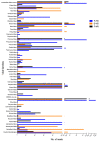Characterization of Pipistrellus pygmaeus Bat Virome from Sweden
- PMID: 36016275
- PMCID: PMC9415950
- DOI: 10.3390/v14081654
Characterization of Pipistrellus pygmaeus Bat Virome from Sweden
Abstract
Increasing amounts of data indicate that bats harbor a higher viral diversity relative to other mammalian orders, and they have been recognized as potential reservoirs for pathogenic viruses, such as the Hendra, Nipah, Marburg, and SARS-CoV viruses. Here, we present the first viral metagenomic analysis of Pipistrellus pygmaeus from Uppsala, Sweden. Total RNA was extracted from the saliva and feces of individual bats and analyzed using Illumina sequencing. The results identified sequences related to 51 different viral families, including vertebrate, invertebrate, and plant viruses. These viral families include Coronaviridae, Picornaviridae, Dicistroviridae, Astroviridae, Hepeviridae, Reoviridae, Botourmiaviridae, Lispviridae, Totiviridae, Botoumiaviridae, Parvoviridae, Retroviridae, Adenoviridae, and Partitiviridae, as well as different unclassified viruses. We further characterized three near full-length genome sequences of bat coronaviruses. A phylogenetic analysis showed that these belonged to alphacoronaviruses with the closest similarity (78-99% at the protein level) to Danish and Finnish bat coronaviruses detected in Pipistrellus and Myotis bats. In addition, the full-length and the near full-length genomes of picornavirus were characterized. These showed the closest similarity (88-94% at the protein level) to bat picornaviruses identified in Chinese bats. Altogether, the results of this study show that Swedish Pipistrellus bats harbor a great diversity of viruses, some of which are closely related to mammalian viruses. This study expands our knowledge on the bat population virome and improves our understanding of the evolution and transmission of viruses among bats and to other species.
Keywords: Sweden; bat; coronavirus; metagenomics; virome.
Conflict of interest statement
The authors declare no conflict of interests.
Figures





Similar articles
-
Virome analysis for identification of novel mammalian viruses in bat species from Chinese provinces.J Virol. 2012 Oct;86(20):10999-1012. doi: 10.1128/JVI.01394-12. Epub 2012 Aug 1. J Virol. 2012. PMID: 22855479 Free PMC article.
-
Bat guano virome: predominance of dietary viruses from insects and plants plus novel mammalian viruses.J Virol. 2010 Jul;84(14):6955-65. doi: 10.1128/JVI.00501-10. Epub 2010 May 12. J Virol. 2010. PMID: 20463061 Free PMC article.
-
A viral metagenomic survey identifies known and novel mammalian viruses in bats from Saudi Arabia.PLoS One. 2019 Apr 10;14(4):e0214227. doi: 10.1371/journal.pone.0214227. eCollection 2019. PLoS One. 2019. PMID: 30969980 Free PMC article.
-
The Virome of Bats Inhabiting Brazilian Biomes: Knowledge Gaps and Biases towards Zoonotic Viruses.Microbiol Spectr. 2023 Feb 14;11(1):e0407722. doi: 10.1128/spectrum.04077-22. Epub 2023 Jan 10. Microbiol Spectr. 2023. PMID: 36625641 Free PMC article. Review.
-
Zoonotic disease and virome diversity in bats.Curr Opin Virol. 2022 Feb;52:192-202. doi: 10.1016/j.coviro.2021.12.008. Epub 2021 Dec 23. Curr Opin Virol. 2022. PMID: 34954661 Free PMC article. Review.
Cited by
-
Discovery of Novel Viruses in Culicoides Biting Midges in Chihuahua, Mexico.Viruses. 2024 Jul 19;16(7):1160. doi: 10.3390/v16071160. Viruses. 2024. PMID: 39066322 Free PMC article.
-
A Novel Mastadenovirus from Nyctalus noctula Which Represents a Distinct Evolutionary Branch of Viruses from Bats in Europe.Viruses. 2024 Jul 26;16(8):1207. doi: 10.3390/v16081207. Viruses. 2024. PMID: 39205181 Free PMC article.
-
Investigation of the Virome and Characterization of Issyk-Kul Virus from Swedish Myotis brandtii Bats.Pathogens. 2022 Dec 21;12(1):12. doi: 10.3390/pathogens12010012. Pathogens. 2022. PMID: 36678360 Free PMC article.
-
Detection and characterization of bovine coronavirus and rotavirus in calves in Ethiopia.BMC Vet Res. 2025 Feb 28;21(1):122. doi: 10.1186/s12917-025-04563-9. BMC Vet Res. 2025. PMID: 40022093 Free PMC article.
-
Detection and Prevalence of Coronaviruses in European Bats: A Systematic Review.Ecohealth. 2024 Dec;21(2-4):125-140. doi: 10.1007/s10393-024-01688-5. Epub 2024 Nov 23. Ecohealth. 2024. PMID: 39580592 Free PMC article.
References
-
- Burgin C.J., Colella J.P., Kahn P.L., Upham N.S. How many species of mammals are there? J. Mammal. 2018;99:1–14. doi: 10.1093/jmammal/gyx147. - DOI
-
- Wilson D.E., Mittermeier R.A. Handbook of the Mammals of the World, Volume 9: Bats. Volume 9. Lynx Edicoins; Barcelona, Spain: 2019. p. 1008.
-
- Kasso M., Balakrishnan M. Ecological and Economic Importance of Bats (Order Chiroptera) ISRN Biodivers. 2013;2013:187415. doi: 10.1155/2013/187415. - DOI
Publication types
MeSH terms
LinkOut - more resources
Full Text Sources
Miscellaneous

